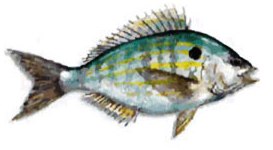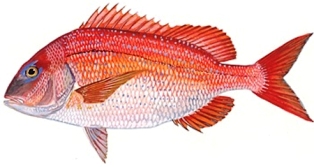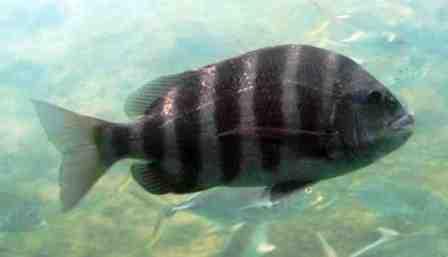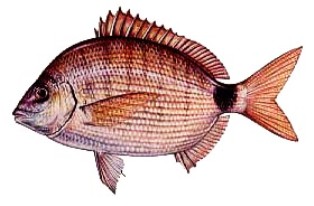Discover Florida Nature
It's time to explore the natural Florida


|
|
|
|
|
 Pinfish
(Lagodon rhomboides) Pinfish are found in coastal
waters from Cape Cod, Massachusetts south through the Gulf of Mexico and
the north coast of Cuba to the Yucatan peninsula. Adult pinfish prefer
protected waters of the Gulf between 30 and 50 feet deep, while
juveniles are common over seagrass beds or other structure such as rocky
bottoms, jetties, pilings, and in mangrove areas where there is cover
from predators. They prefer water that has a higher salinity.
Distinguishing characteristics include its olive back, bluish sides with
yellow stripes and five to six vertical bars on sides. Pinfish have a
silvery sheen overall, with yellow fins and a dark spot on the shoulder.
Adults grow to around 4.5 inches. Adult pinfish prefer protected waters
of the Gulf between 30 and 50 feet deep, while juveniles are common over
seagrass beds or other structure such as rocky bottoms, jetties,
pilings, and in mangrove areas where there is cover from predators. They
prefer water that has a higher salinity. Although they have a good
flavor, pinfish are rarely eaten because they are relatively small fish.
Still, pinfish are a favorite among young anglers because they are fun
to catch. Also, pinfish are a main prey item of larger fish that are
prized by anglers, providing an important link in the food chain.
Scientists have also used pinfish extensively to test the toxicity of
hydrocarbons to determine the effects oil spills might have on marine
life. Pinfish
(Lagodon rhomboides) Pinfish are found in coastal
waters from Cape Cod, Massachusetts south through the Gulf of Mexico and
the north coast of Cuba to the Yucatan peninsula. Adult pinfish prefer
protected waters of the Gulf between 30 and 50 feet deep, while
juveniles are common over seagrass beds or other structure such as rocky
bottoms, jetties, pilings, and in mangrove areas where there is cover
from predators. They prefer water that has a higher salinity.
Distinguishing characteristics include its olive back, bluish sides with
yellow stripes and five to six vertical bars on sides. Pinfish have a
silvery sheen overall, with yellow fins and a dark spot on the shoulder.
Adults grow to around 4.5 inches. Adult pinfish prefer protected waters
of the Gulf between 30 and 50 feet deep, while juveniles are common over
seagrass beds or other structure such as rocky bottoms, jetties,
pilings, and in mangrove areas where there is cover from predators. They
prefer water that has a higher salinity. Although they have a good
flavor, pinfish are rarely eaten because they are relatively small fish.
Still, pinfish are a favorite among young anglers because they are fun
to catch. Also, pinfish are a main prey item of larger fish that are
prized by anglers, providing an important link in the food chain.
Scientists have also used pinfish extensively to test the toxicity of
hydrocarbons to determine the effects oil spills might have on marine
life. Red
Porgy
(Pagrus pagrus) The red porgy occurs in the eastern
Atlantic from the British Isles south to Angola and in the western
Atlantic from New York to Argentina. Red porgy are usually found near
hard-bottom areas off the west-central Florida coast and the Florida
Middle Ground, and the Flower Garden Banks off Texas. Smaller red porgys
are commonly found in shallower waters but the adults prefer deeper
waters. Red porgies are medium-sized, humpbacked fish with compact,
stocky bodies. They are speckled with small blue spots and tinged with
silver; tails and fins are more pinkish. The feed on a variety of
invertebrates and are commercially harvested. Studies of reef habitat
along the southeastern United States indicate that red porgies are most
common over inshore live-bottom habitats and over shelf-edge,
rocky-rubble, and rock outcrop habitats. In the South Atlantic, red
porgy populations appear to be recovering, although stocks remain
overfished. The status of populations in the Gulf of Mexico is unknown. Red
Porgy
(Pagrus pagrus) The red porgy occurs in the eastern
Atlantic from the British Isles south to Angola and in the western
Atlantic from New York to Argentina. Red porgy are usually found near
hard-bottom areas off the west-central Florida coast and the Florida
Middle Ground, and the Flower Garden Banks off Texas. Smaller red porgys
are commonly found in shallower waters but the adults prefer deeper
waters. Red porgies are medium-sized, humpbacked fish with compact,
stocky bodies. They are speckled with small blue spots and tinged with
silver; tails and fins are more pinkish. The feed on a variety of
invertebrates and are commercially harvested. Studies of reef habitat
along the southeastern United States indicate that red porgies are most
common over inshore live-bottom habitats and over shelf-edge,
rocky-rubble, and rock outcrop habitats. In the South Atlantic, red
porgy populations appear to be recovering, although stocks remain
overfished. The status of populations in the Gulf of Mexico is unknown.  Sheepshead
(Archosargus rhomboidalis) The distribution of the sheepshead in
the western Atlantic Ocean includes coastal waters from Nova Scotia
through the Gulf of Mexico with the densest populations occurring off
southwest Florida. Primarily occurring inshore around rock pilings,
jetties, mangrove roots, and piers as well as in tidal creeks, the
sheepshead prefers brackish waters. It seeks out warmer spots near
spring outlets and river discharges and sometimes enters freshwater
during the winter months. This fish moves to offshore areas in later
winter and early spring for spawning, which sometimes occurs over
artificial reefs and navigation markers. The sheepshead has an
oval-shaped, deep body with a blunt snout and small, nearly horizontal
mouth. The posterior nostril is slit-like in appearance. Dorsal and anal
fins include stout, short spines. The second spine of the anal fin is
enlarged. Pectoral fins are long, extending beyond the anal opening when
pressed close to the body. The caudal fin is shallowly forked. Teeth of
the sheepshead include well-defined incisors, molars, and grinders.
Although it reaches a maximum size of about 29.5 inches (76 cm) and 22
pounds (9.6 kg), adult sheepshead are most commonly about 1-8 pounds
(.5-3.6 kg) and 14-18 inches (35 cm). Maximum known lifespan of the
sheepshead is at least 20 years with maturity typically reached at 2
years of age. The sheepshead is an omnivorous fish, feeding on
invertebrates, small vertebrates and occasional plant material. Large
juveniles and adults prey on blue crab, oysters, clams, crustaceans, and
small fish including young Atlantic croakers. Sheepshead
(Archosargus rhomboidalis) The distribution of the sheepshead in
the western Atlantic Ocean includes coastal waters from Nova Scotia
through the Gulf of Mexico with the densest populations occurring off
southwest Florida. Primarily occurring inshore around rock pilings,
jetties, mangrove roots, and piers as well as in tidal creeks, the
sheepshead prefers brackish waters. It seeks out warmer spots near
spring outlets and river discharges and sometimes enters freshwater
during the winter months. This fish moves to offshore areas in later
winter and early spring for spawning, which sometimes occurs over
artificial reefs and navigation markers. The sheepshead has an
oval-shaped, deep body with a blunt snout and small, nearly horizontal
mouth. The posterior nostril is slit-like in appearance. Dorsal and anal
fins include stout, short spines. The second spine of the anal fin is
enlarged. Pectoral fins are long, extending beyond the anal opening when
pressed close to the body. The caudal fin is shallowly forked. Teeth of
the sheepshead include well-defined incisors, molars, and grinders.
Although it reaches a maximum size of about 29.5 inches (76 cm) and 22
pounds (9.6 kg), adult sheepshead are most commonly about 1-8 pounds
(.5-3.6 kg) and 14-18 inches (35 cm). Maximum known lifespan of the
sheepshead is at least 20 years with maturity typically reached at 2
years of age. The sheepshead is an omnivorous fish, feeding on
invertebrates, small vertebrates and occasional plant material. Large
juveniles and adults prey on blue crab, oysters, clams, crustaceans, and
small fish including young Atlantic croakers.
 Spottail
Pinfish
(Diplodus holbrooki) Spot tail pinfish is also known
as porgy, spot, spot-tail porgy, and sailor’s choice. They are similar
in appearance to the pinfish, but they have a large black spot in front
of the base of the tail. According to the biologists, they hang around
in shallow coastal waters and in lower areas of coastal bays and sounds.
Spotted pinfish prefer flat, vegetated bottoms such as beds of sea
grass, where the feed on a mixture of plants (such as Thalassia) and
small invertebrates.They are most frequently caught in offshore waters
around hard bottom and reefs, and they are good baits, cut or alive.
They are a fair pan-fish. Spotted pinfish grow to around ten inches.
Spottail pinfish are almost totally gray in color, with a large, black
spot on the distal end of the caudal peduncle. Spottail pinfish are
exclusive to the western Atlantic ocean. They can be found from
Chesapeake bay to southern Florida. Spottail pinfish are also known from
the northern Gulf of Mexico, but are not known from the West Indies.
Spottail pinfish school in small numbers, but generally mix with many
other species. Spottail
Pinfish
(Diplodus holbrooki) Spot tail pinfish is also known
as porgy, spot, spot-tail porgy, and sailor’s choice. They are similar
in appearance to the pinfish, but they have a large black spot in front
of the base of the tail. According to the biologists, they hang around
in shallow coastal waters and in lower areas of coastal bays and sounds.
Spotted pinfish prefer flat, vegetated bottoms such as beds of sea
grass, where the feed on a mixture of plants (such as Thalassia) and
small invertebrates.They are most frequently caught in offshore waters
around hard bottom and reefs, and they are good baits, cut or alive.
They are a fair pan-fish. Spotted pinfish grow to around ten inches.
Spottail pinfish are almost totally gray in color, with a large, black
spot on the distal end of the caudal peduncle. Spottail pinfish are
exclusive to the western Atlantic ocean. They can be found from
Chesapeake bay to southern Florida. Spottail pinfish are also known from
the northern Gulf of Mexico, but are not known from the West Indies.
Spottail pinfish school in small numbers, but generally mix with many
other species. |
|
|
Advertise | Privacy Statement | Dog Encyclopedia | Video |Contact | Alaska Nature |
|